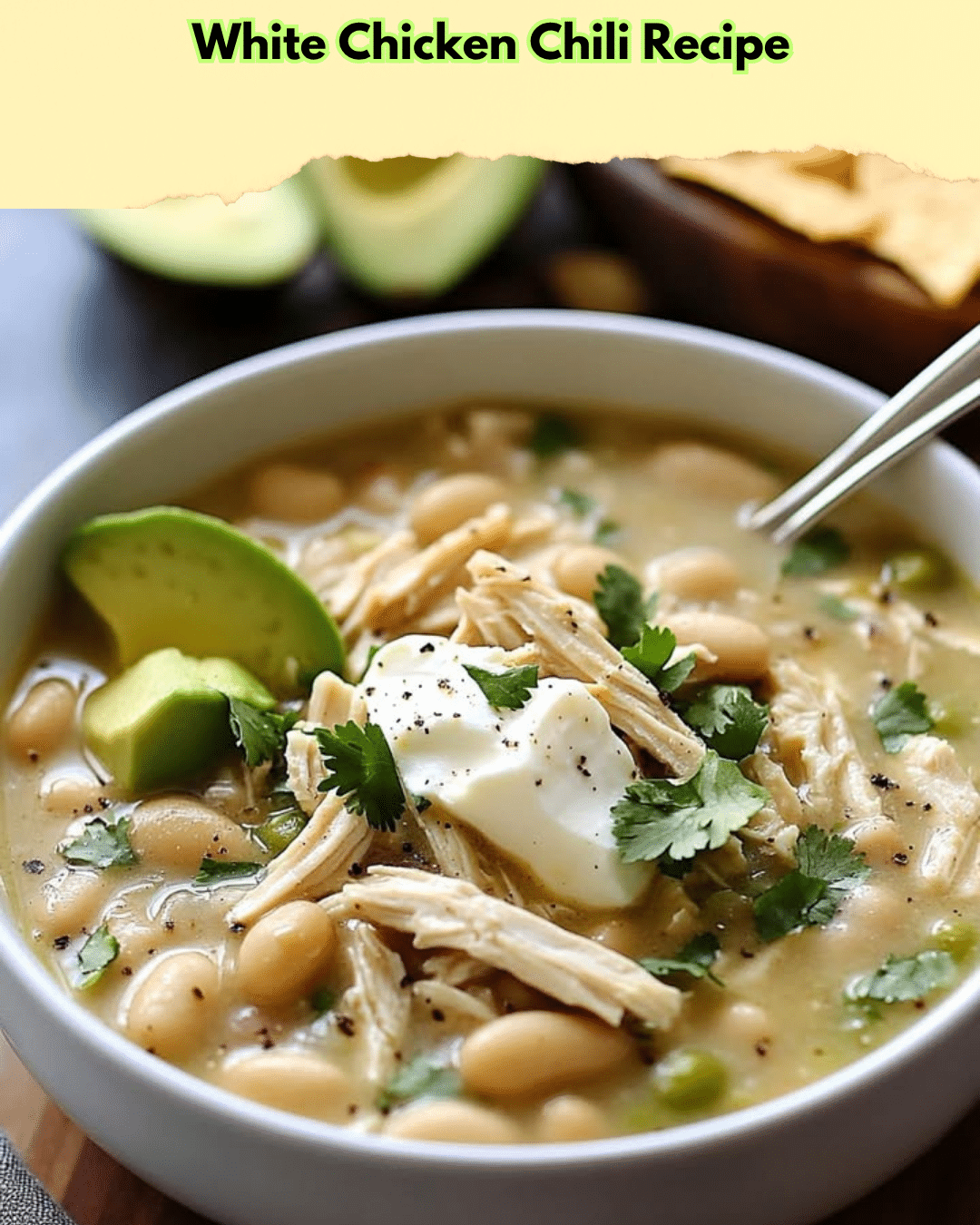White Chicken Chili Recipe: A Flavorful and Comforting Dish
This white chicken chili recipe is the perfect combination of creamy white beans, tender chicken, and a delicious blend of spices that will warm you from the inside out. Whether you’re looking for a satisfying weeknight dinner or a dish to impress your guests, this easy white chicken chili recipe is sure to please. With its zesty lime and fresh cilantro, it’s packed with flavor and gives a delightful twist on traditional chili recipes.
With its creamy texture and a kick of heat, this white chicken chili is truly comforting. The rich flavors come together seamlessly, making it an ideal dish for a cold night or a cozy get-together with loved ones. Not only does it taste incredible, but it’s also simple and quick to prepare, allowing you to enjoy a hearty meal without spending hours in the kitchen.
Quick Recipe Highlights
- Flavor Profile: A blend of spicy and zesty with a creamy base that balances the heat perfectly.
- Texture: Creamy with tender chicken pieces and slight crunch from peppers and onions.
- Aroma: Aromatic spices mingled with fresh lime and cilantro.
- Visual Appeal: A vibrant mix of creamy textures with flecks of green and red from fresh ingredients.
- Skill Level Needed: Basic cooking skills with simple steps and readily accessible ingredients.
- Special Equipment: A large pot or Dutch oven to ensure even cooking.
Recipe Overview
- Difficulty Level: This recipe is easy, thanks to straightforward steps and common ingredients. It’s ideal for beginner cooks as most of the work involves simple cutting and simmering.
- Category: Comfort food that stands out as a hearty, wholesome meal suitable for lunch or dinner.
- Cuisine: While this white chicken chili may have Southwestern roots, it incorporates universal flavors making it a cross-cultural favorite.
- Cost: This white chicken chili recipe is cost-effective with ingredients that are readily available and inexpensive, like canned beans, chicken, and spices.
- Season: Best enjoyed in the cooler months for its warming properties, though delightful all year due to its refreshing, zesty twist.
- Occasion: Perfect for family dinners, casual gatherings, or potlucks where you need to serve something crowd-pleasing without much fuss.
Why You’ll Love This Recipe
The taste and texture of this white chicken chili are what truly set it apart. Each bite offers a rich, creamy base, contrasted with chunks of tender chicken and the subtle crunch of fresh vegetables. The heat from the spices is perfectly tempered by the creamy broth, providing a meal that’s soothing and satisfying.
Convenience-wise, this recipe is a game-changer. It’s quick to prepare, meaning you can whip it up even on the busiest of evenings. Whether you’re an experienced chef or just starting, the simplicity of this recipe ensures a stress-free cooking experience.
Nutritionally, white chicken chili is a fantastic choice. It’s packed with protein from the chicken and beans, while vegetables add a boost of vitamins and minerals. It’s hearty yet well-balanced, offering a wholesome meal that’s nourishing and energizing.
Apart from being a delight to the senses, this recipe carries significant social value. Serve it as a casual dish at family gatherings or intimate dinners with friends, and it’s guaranteed to foster conversation and connections over a delicious bowl of homemade goodness.
Cost-effectiveness is another reason to love this white chicken chili recipe. With ingredients that don’t break the bank, you can enjoy a gourmet meal that feels lavish without spending a fortune.
Historical Background and Cultural Significance
The origin of white chicken chili isn’t as clearly defined as its red counterpart, but it’s thought to have emerged as a lighter, Southwestern-inspired alternative. Unlike traditional red beef chili, which has its roots in Texan cooking, white chicken chili adapts influences from Mexican cuisine, embracing beans, chicken, and spices unique to this variation.
Over time, it’s become a staple in many American households. Its adaptability and warmth make it a popular choice, especially during the autumn and winter months when comfort food reigns supreme. The recipe continues to evolve as cooks experiment with spices and garnish, adding personal twists.
Culturally, white chicken chili represents a blend of culinary traditions, merging the Southwestern penchant for chili with a preference for lighter, chicken-based dishes. This fusion highlights the cultural diversity and creativity present in modern cookery, as different traditions meld to create new, enticing dishes.
Regional variations abound, with some areas adding additional heat through jalapeños or incorporating hatch chiles unique to their locale. This adaptability means the recipe can be tailored to reflect local tastes and ingredient availability, ensuring its status as a nationwide favorite.
Ingredient Deep Dive
Chicken, the central ingredient of this dish, was always destined for greatness in a chili. Lean and versatile, chicken takes on the flavors of the spices and complements the creamy base beautifully. To ensure perfection, choose skinless, boneless chicken breasts or thighs for ease of preparation and reliable results.
Beans, specifically white beans like cannellini or Great Northern beans, add heartiness and depth to the dish. Besides providing protein and fiber, they bring a creamy consistency without the need for heavy cream. If unavailable, chickpeas or even pinto beans offer acceptable variations.
Spices play a crucial role in defining the character of the chili. Cumin, coriander, and chili powder provide heat and warmth, whereas garlic and onions balance these flavors with their aromatic profiles. The balance and choice of spices can be tailored to personal taste, creating a customized experience with each pot.
Cilantro’s fresh pop offers contrast, making it an essential garnish. However, parsley is a suitable substitute if cilantro doesn’t cater to your palate. Lime juice adds acidity and brightness, cutting through the richness and providing a refreshing finish.
Common Mistakes to Avoid
- Overcooking the chicken: This can lead to dry, tough meat. Ensure you cook the chicken just until it’s done for the best texture.
- Using too many spices: Although aromatic, excessive spice can overpower the other ingredients. Measure carefully to maintain balance.
- Skipping the simmer: Allowing the chili to simmer ensures flavors meld and deepen, creating a cohesive flavor profile.
- Not seasoning properly: Taste test as you go. Adequate seasoning is crucial for bringing out the flavors.
- Using the wrong beans: Different beans have different textures and flavors. Stick with white beans for the authentic experience.
- Skipping fresh elements: Lime juice and cilantro provide vibrancy and should not be omitted.
- Improper storage: Improperly stored leftovers can turn, so use airtight containers and refrigerate promptly.
- Cooking on too high heat: Low and slow simmering ensures tender chicken and melded flavors.
Essential Techniques
Sautéing is crucial in building flavor and depth. Start by sautéing onions and garlic, as this releases their aromas, necessary for a flavorful base. Ensure not to brown them excessively, which can lead to bitterness.
Deglazing the pan with broth or water after sautéing prevents sticking and incorporates every bit of flavor into the dish. This technique lifts caramelized bits from the bottom, enriching the chili with deep, savory notes.
Simmering, rather than boiling, is key for blending flavors while keeping the chicken tender. Low, gentle heat is all that’s needed to achieve a rich, cohesive flavor without drying out the meat.
Correct seasoning, involving gradual flavor adjustments, ensures a perfect final dish. Season conservatively initially, then add more seasonings incrementally to reach desired taste levels without overpowering.
Pro Tips for Perfect White Chicken Chili
Ensure you use good-quality chicken, as it will dramatically impact the flavor and texture of the final dish. Fresh, locally sourced chicken often provides superior taste.
For an extra creaminess, consider adding a dollop of sour cream or cream cheese toward the end of cooking. This addition can enhance the mouthfeel and richness of the chili.
If you prefer a spicier kick, incorporate diced jalapeños or a sprinkle of cayenne pepper as you cook. Tailor the amount to suit your heat tolerance.
Bringing out the cheese: Adding shredded cheese like Monterey Jack or Pepper Jack can give an additional layer of flavor and texture, making it cheesier and richer.
Double the zest for balance: Don’t shy away from using both zest and juice of the lime for more fragrance and depth.
Garnishing intentionally adds not just flavor, but a visual pop. Neatly sliced avocado or shaved radishes provide color contrast and texture while enhancing the chili’s aesthetic.
Experiment with herbs: Besides cilantro, herbs like fresh oregano or thyme can add new dimensions and aroma to keep the chili exciting.
Variations and Adaptations
Regional variations can vary based on the heat level preferred within an area. In regions favoring spicy foods, additional hot chilies might be included for an intense kick.
Adapting the recipe seasonally is easy. In winter, you might prefer a heavier, richer stock, while in summer, adding corn can give a sweet, fresh burst aligning it with rising temperatures.
Dietary modifications like using plant-based proteins such as tofu or tempeh can accommodate vegetarian or vegan diets. For gluten-free diets, verify all canned ingredients are certified accordingly.
Flavor variations can be achieved by experimenting with different types of beans or switching up the protein choice to turkey or pork, offering new experiences without altering the fundamental nature of the dish.
Texture modifications might involve puréeing a portion of the beans to create a smoother, richer texture. Alternatively, adding more vegetables such as bell peppers or carrots can offer a crunchier bite.
Offbeat presentation alternatives explore serving the chili in a bread bowl or topping it with crispy tortilla strips for added crunch and visual appeal.
Serving and Presentation Guide
Present the chili in deep bowls to keep it warm and thorough mixing. Consider white or neutral tones to colorfully contrast with the dish’s natural hues.
Garnishing with vibrant toppings like cilantro, lime wedges, or crushed tortilla chips adds both flavor and visual excitement, inviting eaters to customize their serving.
Traditionally, white chicken chili pairs well with cornbread or warm flour tortillas which can be served on the side to complement the rich flavors and enhance the meal experience.
Modern serving suggestions might include topping with fresh avocado slices or scattering with microgreens to add a contemporary touch.
Temperature considerations are key: make sure to serve the dish hot, directly from the stove to maintain its warming quality.
Portion control is essential, especially when serving at events. Consider ladling smaller amounts into bowls with the option for guests to refill, accommodating different appetites without waste.
Wine and Beverage Pairing
For wine lovers, a crisp white wine like a Sauvignon Blanc or a slightly oaked Chardonnay compliments the flavors of the white chicken chili and enhances the meal’s creaminess.
Non-alcoholic alternatives include lime-infused sparkling water or a hearty fruit punch, which provide refreshment while supporting the chili’s robust characteristics.
If coffee or tea is more your style, a well-balanced, medium-roast coffee or a light herbal tea featuring mint or chamomile works, offsetting the chili’s heat with calming flavors.
Temperature considerations for beverages are vital: chilled or room temperature is recommended to offer contrast against the hot dish.
Serving suggestions: Ensure all pairings have plenty of refreshing elements to cleanse the palate between bites, maintaining a fresh and enjoyable dining experience.
Storage and Shelf Life
Store leftovers in an airtight container in the refrigerator for up to three days, ensuring freshness and flavor retention.
Maintain a refrigerator temperature below 40°F to inhibit bacterial growth and extend the dish’s shelf life.
When selecting containers, opt for glass or BPA-free plastic for odor-free, durable storage, and ease of reheating.
Signs of spoilage can include an off-smell or discoloration of the chicken or broth. If any doubts arise, it’s safer to discard the chili.
Reheat the chili gently on the stove over low heat or in the microwave until it reaches an internal temperature of at least 165°F to ensure safe consumption.
Freezing guidelines: This chili freezes well; allow it to cool completely before transferring into freezer-safe bags or containers for up to three months.
Make Ahead Strategies
Plan your prep timeline by cutting vegetables or cooking chicken a day in advance, streamlining the process when it’s time to cook.
Between steps, storing prepped ingredients in airtight containers in the refrigerator ensures they stay fresh and ready for use.
Quality is generally unaffected when preparing the chili ahead, though vibrant garnishes may need refreshing when serving to maintain visual appeal.
When assembling, layer flavors by adding herbs last, letting them infuse without overpowering the dish.
Reheating in a slow cooker or gently on the stove preserves safety and texture while ensuring the chili remains tender and flavorful.
Add fresh elements such as lime juice and cilantro just before serving to heighten their aromas and taste, preserving the chili’s dynamic qualities.
Scaling Instructions
To halve the recipe, adjust all ingredient amounts evenly, paying special attention to seasoning, which might need more incremental adjustment to maintain balance.
Doubling or tripling requires careful attention to pot size, ensuring it comfortably holds all ingredients for even cooking and stirring.
Equipment adjustments such as using a larger stockpot or Dutch oven may be necessary to accommodate larger quantities without affecting cooking quality.
Timing modifications are minimal, though larger volumes might require slightly extended cooking times to ensure the chicken is thoroughly cooked.
Storage considerations for scaled recipes should account for adequate space in refrigerators or freezers, especially if anticipating leftovers.
Nutritional Deep Dive
White chicken chili provides a balanced macro profile, rich in protein, moderate in fats, and appropriately low in carbohydrates thanks to lean chicken and beans.
The micronutrient analysis reveals substantial levels of vitamin C from lime, along with iron and fiber from the beans, promoting holistic health benefits.
Health benefits of this chili include contributing to a well-rounded diet, supporting immune function with the garlic, and maintaining energy levels with healthy, complex proteins.
Dietary considerations mean adjusting ingredients with vegetarian preferences in mind or increasing spices for those requiring additional heat for metabolism support.
Portion analysis aids in managing servings effectively, with an average serving providing approximately 350-400 calories, etching well into a balanced daily intake.
Weight management tips advocate enjoying this chili within a varied diet, focusing on portion control, and selecting lean cuts of chicken to keep calorie content in check.
Dietary Adaptations
For a gluten-free variation, ensure all canned components are certified gluten-free, replacing any broth with a gluten-free variety.
Creating a dairy-free option is simple by excluding cream cheese or substituting it with a plant-based alternative like coconut milk for a similar creaminess without lactose.
For a vegan variation, substitute chicken with plant-based protein like lentils or jackfruit, retaining the dish’s hearty appeal devoid of animal products.
Low-carb followers could reduce bean quantities, emphasizing chicken and vegetables, while keto adherers might swap beans for cauliflower, lessening carbohydrate intake.
Paleo diets can benefit from eliminating beans and boosting chicken with additional fiber-rich vegetables like zucchini or mushrooms for fulfillment.
For low-FODMAP compliance, replace onions and garlic with their oil-infused counterparts, retaining flavor while accommodating sensitive digestive systems.
Troubleshooting Guide
Texture issues, such as a watery broth, can be resolved by simmering the chili uncovered to promote evaporation, thickening its consistency.
Balancing flavors is achieved by following a taste-as-you-go method; add salt, acid, or sweet components incrementally to reach ideal harmony.
Temperature problems often arise from hot spots in cooking vessels. Stir regularly to ensure even cooking and avoid scorching on the bottom.
Equipment challenges can be minimized by verifying compatibility and size; a large, heavy-bottomed pot distributes heat and prevents sticking.
Ingredient substitutions should focus on flavor compatibility and consistency in texture. For example, different beans should maintain size and creaminess.
Timing concerns include ensuring chicken is fully cooked for safety; using a food thermometer can alleviate uncertainty and confirm proper doneness.
Recipe Success Stories
Community feedback highlights the recipe’s versatility and universal appeal, praised for its balance of speed, flavor, and satisfaction in myriad households.
Creative variations like substituting turkey or opt-in additional chilies showcase its adaptability, with each rendition receiving glowing reviews and positive adaptation stories.
Photographing the richly colored chili against contrastive dishes or garnishing vibrantly helps illustrate its appeal, offering vivid images that elicit reaction and pride in presentation.
Reader suggestions recommending appliance alternatives for cooking have inspired adoption in slow cookers or instant pots, broadening ease and application.
Cooking enthusiasts praise this recipe for being approachable yet distinctly tasteful, maintaining its position as a favorite in the culinary community.
Frequently Asked Questions
Q: Can I make this chili in a slow cooker?
A: Yes, adjust the cooking time to about 4-6 hours on low or 2-3 hours on high to ensure thorough cooking without drying out the chicken.
Q: Is it possible to make this recipe vegetarian?
A: Definitely, substitute the chicken with plant-based proteins such as tofu, and use vegetable broth for a delicious vegetarian version.
Q: How can I store and freeze this chili properly?
A: Cool the chili completely, then transfer it into airtight containers or freezer bags, leaving some space at the top. Freeze for up to three months.
Q: Are there nut-free alternatives for garnishing?
A: Yes, avoid nuts entirely and focus on fresh herbs like cilantro or sliced avocado for toppings.
Q: How can I thicken up my chili?
A: Mash a portion of the beans to release starches or simmer uncovered until desired consistency is reached.
Q: What’s the best way to reheat leftover white chicken chili?
A: For best results, reheat gently on the stove or microwave, stirring frequently, and add a splash of water if needed to regain desired consistency.
Q: Can I spice up the chili without altering the flavor completely?
A: Sure, introduce heat carefully with jalapeños or a pinch of cayenne for an extra kick without overwhelming the established flavors.
Q: What can accompany white chicken chili for a complete meal?
A: Consider cornbread, tortilla chips, or a refreshing side salad to complete the meal.
Q: Is there a way to reduce sodium in this recipe?
A: Opt for low-sodium or no-salt-added canned ingredients, and use seasoning sparingly, adding fresh herbs for flavor boost without excess salt.
Q: How can I retain the color vibrancy in my white chicken chili?
A: Add fresh herbs and lime juice just before serving to refresh the colors and enhance visual appeal.
Additional Resources
Explore related recipes that capture similar warmth and comfort, such as traditional beef chili or black bean turmeric soup, to expand your recipe repertoire.
Technique guides highlight essential skills like proper sautéing and simmering, helping refine your culinary methods for outstanding results consistently.
Ingredient information delves into the specific beans, spices, and chicken choices, offering excellent insights into selecting the best quality for optimal flavor.
Equipment recommendations, particularly high-quality pots and storage solutions, ensure the ideal cooking and preservation conditions, enhancing your experience.
Seasonal variations suggest intuitive modifications or alternatives that align ingredients with freshest seasonal produce, improving freshness and taste in your dishes.
Print
White Chicken Chili Recipe
Description
A comforting and hearty dish with tender chicken, white beans, and a rich, flavorful broth.
Ingredients
For the Crust:
- 1 lb boneless, skinless chicken breasts, cubed
- 2 cans (15 oz each) white beans, drained and rinsed
- 1 medium onion, chopped
- 2 cloves garlic, minced
- 1 can (4 oz) diced green chilies
- 4 cups chicken broth
- 1 tsp cumin
- 1 tsp oregano
- 1/2 tsp chili powder
- Salt and pepper to taste
- 2 tbsp olive oil
- 1 cup corn kernels
- 1/4 cup fresh cilantro, chopped
Instructions
1. Prepare the Crust:
- Heat olive oil in a large pot over medium heat. Add the chopped onion and garlic, and sauté until the onion is soft and translucent.
- Add the cubed chicken to the pot and cook until lightly browned on all sides. Stir in cumin, oregano, chili powder, salt, and pepper.
- Add the diced green chilies, chicken broth, and white beans. Bring the mixture to a simmer and cook for 20 minutes. Stir in the corn and cook for an additional 5 minutes. Garnish with fresh cilantro before serving.
Notes
You can customize the seasonings to taste.




